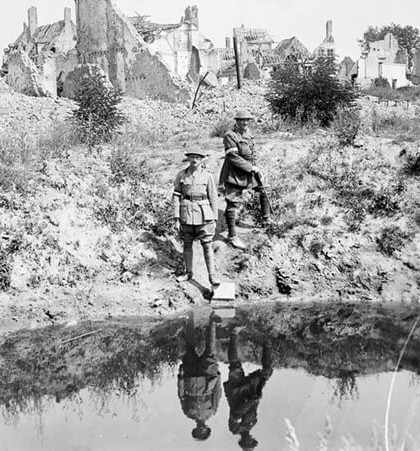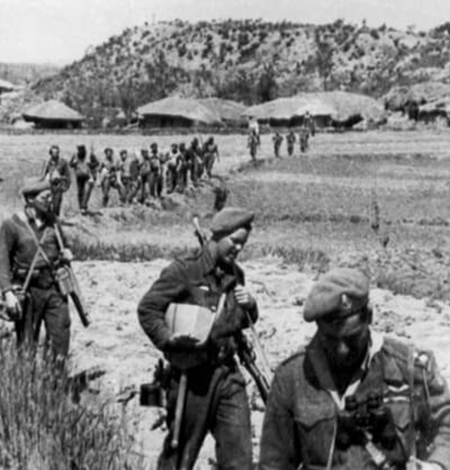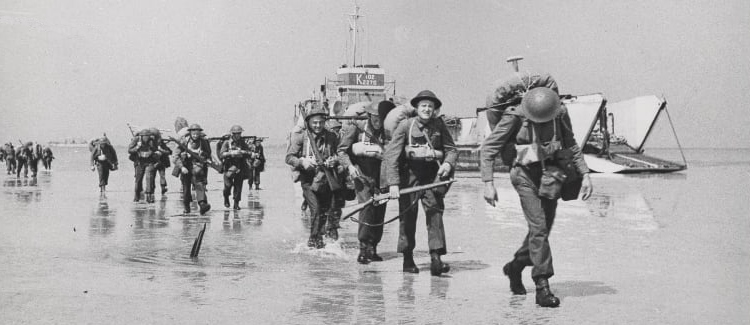Resources for Secondary Students
Major Talbot Papineau
This lesson explores Major Talbot Papineau, a French-Canadian Major who fought with the Princess Patricia’s Canadian Light Infantry during the First World War. Papineau was killed on 30 October 1917 and is remembered on Menin Gate in Ypres, Belgium. Students will watch a short segment (3m:57) of Valour Canada’s award-winning Forgotten Fallen documentary, then discuss questions about Talbot’s life and military service, and conclude the activity by completing a R.A.F.T. assignment. (This lesson will take at least 75 minutes).
Click to download the “Papineau” PDF.
First World War: 20 Questions and Inquiry
This lesson explores Canada’s experience in the First World War. Students will watch two YouTube videos: Forgotten Fallen (29m:25) and General Sir Arthur Currie (4m:05), and then browse the Road to Vimy Ridge: Canada and the First World War. Next, the students will explore each of the 20 questions provided, review the associated research/discussion questions, and then further investigate a FWW topic that interests them. (This lesson will take at least 75 minutes).
Click to download “First World War: 20 Questions” PDF
D-Day: 20 Questions and Inquiry
This lesson explores Canada’s experience on D-Day. Students will watch three YouTube video clips: D-Day Footage of Juno Beach (2m:08), D-Day Series: RCN and Operation Neptune (16m:16), and Canada on D-Day Operation Overlord (10m:06). Next, the students will explore each of the 20 questions provided, review the associated research/discussion questions, and then further investigate a D-Day/Normandy topic that interests them. (This lesson will take at least 1 hour).
Click to download “D-Day: 20 Questions” PDF
Battle of Kapyong: 20 Question and Inquiry
This lesson explores Canada’s experience in the Korean War. Students will watch this Kapyong YouTube video (8m:48). Next, the students will explore each of the 20 questions provided, review the associated research/discussion questions, and then further investigate a Korean War topic that interests them. (This lesson will take at least 1 hour).
Click to download “Battle of Kapyong” PDF
The Sinking of HMHS Llandovery Castle: Case Study
This lesson explores the case of HMHS Llandovery Castle, a hospital ship that was sunk by a German U-boat on 27 June 1918. Students will learn about the sinking, the trial that succeeded it, and reactions from different opposing nations during the war. Then, students will engage with questions, photographs and images, and primary sources to assist their understanding of the events. (This lesson will take at least 75 minutes).
Click to download the “Llandovery Castle” PDF
Click to download the “Llandovery Castle” Supplementary Questions PDF
D-Day Series: RCN and Operation Neptune
This lesson explores the role of the Royal Canadian Navy (RCN) in Operation Neptune and the events on and surrounding D-Day. Students will watch this YouTube video (16m:16) and make written notes about what they see and hear in the video. Next individuals will write a short, 5-7 sentence paragraph about the RCN’s impact on D-Day. Finally, ‘narrative’ and the difference between ‘the past’ and ‘history’ will be defined, compared, and contrasted. (This lesson will take at least 1 hour).
Click to download “D-Day Series: RCN Operation Neptune” PDF
Foreign Policy: Survey and Analysis (Part 1)
This lesson provides an introduction to foreign policy and nationalism. A survey about Canada’s domestic and international priorities will be completed by the students, then their individual and class results will be compared against Canadians’ perspectives relative to those same questions. Part 1 finishes by having each student place themselves, based upon their views on a set of issues, somewhere along the nationalism spectrum (This lesson will take at least 75 minutes).
Click to download the “Foreign Policy” PDF.
Click to download a version for students.
Foreign Policy: Pathfinder Activities (Part 2)
This lesson is a continuation of part 1 (above) that takes students into a set of real world examples, including (i) Canada’s role in Afghanistan and the Middle East, (ii) Defending and Protecting the Arctic, and (iii) Human Rights and Canada’s involvement in the UN, each viewed through lenses of domestic security, regional security, the economy, and humanitarianism. (This lesson will take at least 75 minutes).
Click to download “FPolicy Pathfinders” PDF
Resolving the Crisis in Syria: The Ottawa Treaty
Students who experience the “Ottawa Treaty” activity will explore the issues central to the mid-2010’s conflict in Syria and negotiate solutions that will end the fighting, so that aid may be applied, and reconstruction of Syria can begin. The discussions occur within an environment modeled after the United Nations approach, where each student (as individuals or as members of small groups) must research and prepare to represent 1 of 8 nations or political groups that are being affected by the fighting. After their findings have been summarized, the students take turns presenting their perspectives to their peers around the table before the bargaining begins. Finally, an attempt is made to craft a treaty document which will eventually be signed by all representatives who agree to the conditions.
The country/political representation includes: Assad’s Syria, the Syrian Rebels/Free Syria Army, Turkey, Iraq, Kurdistan, Russia, U.S., and the E.U. (We recommend taking at least 1.25 hour in-class for students to prepare and negotiate. In addition, preliminary research and summarizing will take each student at least 1 hour). [Note: This activity was last updated in May 2017 and given the information now available, the activity and resources are likely dated]
Click to download “The Ottawa Treaty” PDF
If you have any questions, concerns, or suggestions about any of the material provided here (or any other Valour Canada education-related content, opportunities, etc.), please contact our educator at: educator@valourcanada.ca
The design of Valour Canada’s educational content is guided primarily by two learning theories:
Six Historical Thinking Concepts (Seixas and Colyer) and Bloom’s Taxonomy (Revised in 2001: Anderson and Krathwol)
Credit: University of Waterloo (Bloom’s Taxonomy), the Historical Thinking Project.





